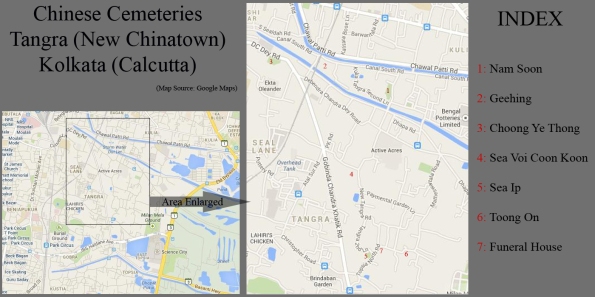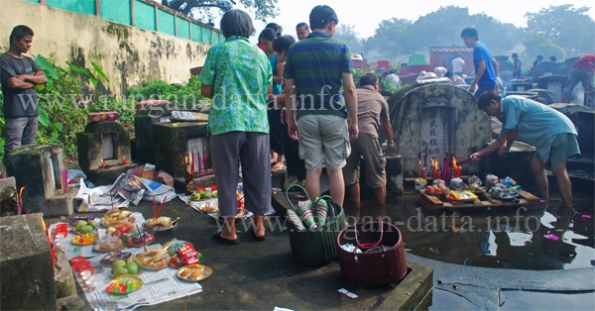Chinese Cemeteries of Tangra (New Chinatown), Calcutta (Kolkata)
Chinese Cemeteries of New Chinatown
Tangra, Kolkata (Calcutta)
Also see: My blog post on Calcutta (Kolkata) Chinatown
The Chinese settlement of Calcutta dates back to the late 18th century when a Chinese trader, Tong Achew settled near present day Budge Budge.
The, then Governor General of India, Warren Hastings, offered Achew land to set up a sugar mill complete with a sugar plantation. Achew soon brought a band of Chinese workers for his sugar project. But Achew died soon after and his mill was soon abandoned. The Chinese also deserted the place, which later came to be known as Achipur, after Achew.
The Chinese moved to the centre of Calcutta, where they settled in Tiretta Bazar. A market place designed by the disposed Italian architect and town planner, Edward Tiretta. It was at this very place, Calcutta’s (Kolkata’s) first Chinatown came up.
Tiretta Bazar, the old Chinatown of Kolkata (Calcutta), is known for its Chinese Breakfast and for the six Chinese Temples belonging to the six Chinese clubs of Kolkata (Calcutta) Chinese Community.
Later on, a large section of Calcutta (Kolkata) Chinese moved to the Eastern part of Calcutta (Kolkata) in Tangra, to form the New China Town. Tangra, Kolkata’s new Chinatown, is known for its sparkling Chinese Restaurants but hidden in Tangra are six Chinese Cemeteries belonging to the same six clubs of Kolkata Chinese Community.
Unlike the Chinese Temples of Old Chinatown, which are very closely located, the cemeteries of New Chinatown are located far and wide. A personal vehicle is the only option of visiting all the cemeteries in a single day.
Not only the cemeteries are scattered over a large area, they are located inside a complex maze of lanes and by-lanes, making it extremely difficult to spot.
For the most convenient way of visiting the Chinese Cemeteries, it is best to take the Dhapa Road from the E M Bypass (Left for vehicles coming from South and right for North) from the Math Pukur Bus Stop (sea map).
Continue along the Dhapa Road till you reach the Dhapa Crossing. Continue along the Dhapa Road towards the canal, don’t take the first bridge but continue along the Dhapa Road, running parallel to the Canal. Take the second bridge to cross the canal and soon you will find the Nam Soon Chinese Cemetery on the left.
The pillars of the Nam Soon Cemetery gate is crowned with porcelain Chinese lions. The lions have long lost their shining polish, but their grace and elegance is enough to remind one of the flourishing days of Calcutta (Kolkata) Chinese.
Nam Soon is a small cemetery and is not well maintained. There is overgrowth of grass and the water in the pond is not well kept either.
The Chinese have strange burial rituals and follow the concept of double burial. After death, the body is first buried in a simple grave. The Chinese Cemeteries normally have a separate place for the first burial. About 2 to 3 years after the first burial, the bones and other remains are dug up and reburied next to the graves of other family members, usually in a horse shoe shaped grave.
Chinese Cemeteries also contained a large horse shoe memorial dedicated to the guardian deity of the club, and the larger cemeteries also contain several sub guardian deities belonging to sub groups of the club.
A small resting shed, for the relatives and friends of the dead, and a pond, for ritual washing, are essential parts of a Chinese Cemetery.
Biding farewell to the Nam Soon Cemetery, continue along the same road towards the second canal, as you reach the second canal, turn left and follow the Canal South Road for the Geehing Cemetery.
Their are several roads and lanes on the left, but to identify the correct lane, look out for a small temple on your right. The lane opposite to the temple leads to the Geehing Cemetery.
The place is extremal difficult to find and you are likely to find a group of local boys playing carom at the entrance. A board at the entrance mentions the year 1917. Like Nam Soon, the small cemetery of Geehing is also ill – maintained and the locals have turned a portion of it into a football field.
Next stop is the Choong Ye Thong Cemetery, the largest and probably the most well maintained of the Chinese Cemeteries of Calcutta’s Old Chinatown. From Geehing follow the Canal South Road and drive below the railway line and take a left turn to the Debendra Chandra Dey Road, a short drive along the road leads to the Choong Ye Thong Cemetery.
A Chinese pagoda style gate welcomes visitors to the cemetery and once inside, a complex maze of graves welcomes the visitors. Most of the graves are horse shoe shaped, as according to Chinese Feng Shui culture, the shape is ideal for conserving energy.
The graves are clustered around large groups belonging to the different sub groups of the Choong Ye Thong Club. But strangely the cemetery does not contain any resting place or a pond, probably they have been taken over by the increasing number of graves!!!
The Nam Soon, Geehing and Choong Ye Thong Chinese Cemeteries are actually located on the outer regions of Tangra. For the remaining three cemeteries, one needs to move deeper inside Tangra, the New Chinatown of Kolkata (Calcutta).
Retrace your steps along the Debandra Chandra Dey Road till you reach a Y – shaped junction. Take the right arm, which happens to be the Gobinda Chandra Khatik Road. Drive below the railway bridge and take a left turn at Tangra Road. Reach a T – junction and take a right turn and on you left will be the gates of the Sea Voi Coon Koon Cemetery.
The arched gateway is marked with metallic Chinese alphabets. The gateway leads to a long passage leading to another gateway, the actual entry to the Sea Voi Coon Koon Cemetery. The cemetery is well maintained. The cemetery has two ponds and a small but elegant resting place. The grass is cut and most of the graves are well maintained.
After the Sea Voi Coon Koon Cemetery, head south along the New Tangra Road, past the Fo Guan Shan Buddhist Temple, which is on the left, and continue through the Tangra Second lane till the Topsia North Road. At this junction and opposite the Hot Wok Restaurant, is the Sea Ip Cemetery. Chinese Calligraphy marks the entrance. A couple of ancient trees provide shades to the few graves. Sadly the cemetery is not well maintained.
Continue along the Topsia North Road till you reach the Sing Cheung Sauce Factory, take a right turn, the second building on the right is the Funeral House. It was once a Chinese Cemetery but it has long been abandoned. All the dead bodies are brought to this funeral house for rituals before being transported to the respective cemeteries.
Continue along the same road and just before the Chinese Kali Temple, you will find the Toong On Cemetery, the entrance blocked by a makeshift tea stall. The board on top of the gates denote the year 1900. The cemetery is more or less well maintained, recently fruit trees are planted to provide shade to the ancient graves. The journey obviously ends with a spontaneous lunch at one of the numerous eateries of Tangra.
The Chinese Cemeteries generally remain empty throughout the year, but during the festival of Tomb Sweeping (Quing Ming) in March / April and Hungry Ghost Festival (Chung Yeung) in August / September the entire Chinese population of Calcutta (Kolkata) visit the cemeteries to pay respect to the departed souls.
Notes:
- There is another Chinese Cemetery in Calcutta (Kolkata), it is located next to the Hsuan Tsang Chinese Buddhist Monastery, Paschim Chowbaga.
- The Fu Kin Chinese Cemetery on Dhapa Road has long been demolished and converted into a cow shed.
Special Thanks:
- Dominic Lee, my Calcutta Chinese friend for accompanying and guiding me during many of my visits to Tangra
- Presidents and Vice – Presidents of the various Calcutta Chinese Clubs for providing valuable information on the Chinese Cemeteries.
- Prof. Kamalika Bose of Centre for Environmental Planning and Technology (CEPT) and her students. Also to the architecture students of Aarhus University, Demmark.
- Rinkoo Bhowmik of The Cha Project
- Last but not least the entire Chinese Population of Calcutta (including those who have migrated) for their constant help, updates and inspiration






















Dear Rangan, The Fu kin (Hokkien) cementry was not demolished by the Chinese. It was maintained by Binny Law’s father and his grandmother and other Law family members were buried about 30 years ago. Due to terror pressure from some anti-socials, the Law family stopped visiting the cementry. The property documents still carry the Hokkien name and is illegally occupied. Hopefully it can be reclaimed and restored so that those souls that are buried there could rest in peace.
Dear Pouchong Lee (Dominic) I said Fu Kin Cemetery was demolished but never said it was demolished by the Chinese.
I am aware of the property crises of Fu Kin Cemetery and came to know about it only from you.
I also sincerely hope that the land can be reoccupied and the cemetery recreated.
Thanks Dominic for your continued support.
Hi. Where is the Fukin Cemetery exactly located? Thanks
It no longer exist, in fact there are no trace of it.
Very interesting.
Making a note of this.
Thanks Indrani, Calcutta Chinatown, both Tangra (New) and Tiretta Bazar (Old) are really exciting areas to explore.
Sadly, in spite of Calcutta housing one of the oldest Chinatowns in the world, it is hardly promoted like Boston, San Fransisco or Sydney.
WHERE WILL I GET MORE DETAILS ABOUT ALL OF THIS I WILL BE NEEDING THIS FOR A PROJECT
Dear Karan for more details please drop me a mail at rangan@rangan-datta.info
Excellent post and I am interested to visit these cemeteries at least once.
Before that I have to talk to you – as the roads appear to be a bit complicated.
Thank you once again for this valuable post.
Very ।informative and well-preserved.
Sir, the list of the cemeteries are not showing here.
Monojit, there is no list. A brief about the cemetries are given here.
Yesterday, when I tried to read this article. This article was not showing. Only the comment section appeared & that’s why I send you a “Hi” on Instagram. But today, it’s showing me.
Actually, I am a student from 3rd year mathematics honours. 2 years ago, I came to know about you. At that time, in one of the facebook groups related to Kolkata, someone wrote about ” Synagogue” and mentioned your name as the credit. I fell in love with the Maghen David & tried to explore & collect information about Jewish Calcutta. Then I came to about the synagogues and a lot from your blog. I fell in love with my city onlyby reading your articles, came to know a lot about my city & I used to travel alone to explore different places whenever I had time. I visited the three synagogues, chinatown, Aami Kolkata Museum,Ghare Baire,etc.Thanks a lot sir.
I need some help from you. I have some passion in photography & I love to explore my city. This year I want to celebrate the Chinese New Year, and, the Chinese Festivals. But I have a lot of confusions. And I hope you can help me sir…. 🥺